In the Valley of the Palkachupa: Conserving an Elusive Bird in the Andes
By Dan Lebbin
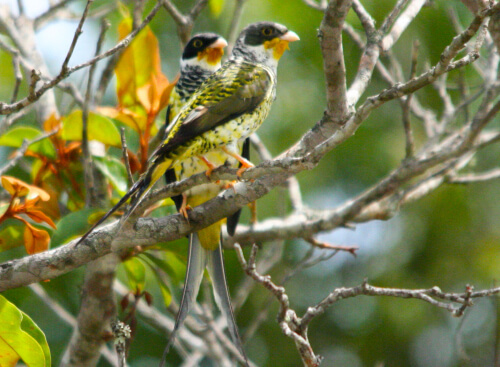
Pair of Palkachupa Cotingas—beneficiaries of a reserve named for the bird in Atén, Bolivia—and the object of the author's visit. Photo by B. Skolnik/ABC
Standing on a ridge top in the highlands of Bolivia, near the isolated village of Atén, I looked out across the irreplaceable landscape known as the Apolo Valley. Beneath the rising clouds and fog, the grassy hills ahead of me rolled up and down for miles, interrupted now and then by twisted trees and patches of green forest.
Pastures where tall grasslands had been mowed by herds of cattle were surrounded by barbed wire nailed to fence posts hacked from local tree trunks. In the distance, the entire valley was surrounded by moist forests and the mountains of the southern Andes.

Ridge-top view from Atén, highlands of Bolivia. Getting here from anywhere is not an easy thing to do. Photo by B. Skolnik/ABC.
These kinds of cerrados—think savannahs—are quite extensive outside the Andes. But the Apolo Valley, at its lowest point, is at least 3,000 feet above sea level. Plants and animals found nowhere else live in this isolated valley. Getting here from anywhere, as I have learned, is not an easy thing to do.
Meet William Ferrufino—and the Palkachupa Cotinga
“That is a guitarerro tree,” says William Ferrufino, who had brought me to this place. Like nearly everybody born and raised in Atén, he's a member of the indigenous Leco people. He's also a moving force behind a fervent effort to conserve the things that make this valley such a treasure.
“It's called the guitarerro tree because its wood is used to make guitars,” he says (in Spanish), while aiming a finger at a tall, pale hardwood near the outer edge of a small, dense patch of trees. But to Ferrufino, it is not the things we make out of the wood that impress him. It's the fact that living guitarerros help sustain a rare, iconic bird found only in the Apolo Valley—an elusive beauty with a long, forked tailed called the Palkachupa Cotinga. (“Palkachupa” is a Quechua word, with “palka” meaning fork and “chupa” meaning tail.)
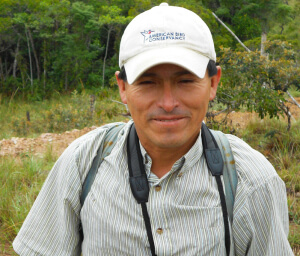
William Ferrufino, member of the indigenous Leco community and a force behind local conservation efforts. Photo by D. Lebbin/ABC, April 2012.
It's an understatement to describe this bird as colorful. The eyes above its blunt, peach-colored beak are ringed with yellow skin surrounded by a mask of dark feathers, contrasting with an orange spot on the chin. On its neck, small speckles and black bars that look a bit like zebra stripes stand out from a white background. The plumage on its back is greenish-yellow and brighter yellow on the underparts. The long, forked tail looks vaguely like a pair of scissor blades curved outward at the ends. Males and females generally have similar appearances, with females being a bit more drab.
William Ferrufino is the keeper of these birds. He watches their scattered nests, tracks threats to their existence, and helps build local support for habitat protection plans. That has made it easier for groups, including ABC and Asociación Armonía, to create a Palkachupa Cotinga Reserve at Atén. Efforts to expand the new reserve by buying nearby lands are underway at this writing.
Road to the Reserve
I flew to Bolivia in 2012 to see this new reserve and—with luck—to see my first Palkachupa Cotinga. I met Ferrufino at my hotel in La Paz, Bolivia's capitol. He had driven up from Atén in an aging red Land Cruiser he had borrowed for the trip. We turned back toward Atén after picking up Rodrigo Soria—a representative of Armonía—and a reporter from a local newspaper.
The nerve-wracking drive that followed lasted 17 hours. Bumpy, narrow, rutted roads led north out of La Paz along Bolivia's Altiplano and Lake Titicaca. Gradually, we wound our way along the eastern side of the Andes, rising toward the mountaintops along humid foothills known as yungas. We were entertained along the way by groups of Torrent Ducks that perched on rocks and swam around in the rapids of a whitewater river next to the road.
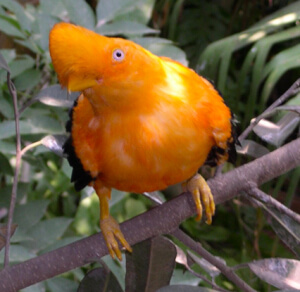
Andean Cock-of-the-Rock, one of the species we observed during our 17-hour drive to the new Palkachupa Cotinga Reserve. Photo by D. Lebbin
Other birds that showed themselves included a neon orange Andean Cock-of-the-Rock and a large black Amazonian Umbrellabird. In the humid cloud forests of the yungas, at least 140 large green and gold Military Macaws gathered before heading to roost for the night. That was just before we turned a corner and discovered that the road ahead of us had been buried by a landslide. Fortunately, a bulldozer was already clearing it when we arrived, so we only had to wait a few hours before proceeding. We arrived in Atén in the middle of the night, and made plans to see the Palkachupa Cotinga the next day.
While we drove, I spoke with Soria about some of the work Armonía has been doing in the Apolo Valley. In recent years the group had renovated Aten's only school and purchased land that now comprises the new reserve. Armonía is also leading an attempt to expand the reserve by purchasing additional lands used by the Palkachupa Cotinga; if these deals go through they will protect an important source of water used by people living in Atén. Armonía is also laying plans to help the local people set up honey production businesses in the bird reserve.
While those changes were taking place, Ferrufino was traversing this valley, watching the birds. When he wasn't driving borrowed motorcycles, he was walking long distances in search of isolated Palkachupa nests. He says he often finds these nests in the branches of twisted trees called Iscachupi in the language of the Leco people. He has also found nests on bare rocks. On top of all of that, in an attempt to increase Palkachupa breeding, Ferrufino told me that he had begun constructing artificial Palkachupa nests. As far as I knew, no bird had ever used a cup nest built by human hands before, but Ferrufino told me that at least one pair of Palkachupas had used his nest during the 2011-2012 breeding season.
A Passion for the Palkachupa
I asked Ferrufino why he does this kind of work, and his answer was a simple one. For as long he remembers, he has had a passion for birds in general and the Palkachupa in particular. When he isn't with these birds, he tries to share his passion with young students at the school in Atén or with local cattle ranchers.
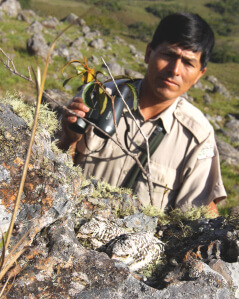
William Ferrufino has had a life-long love of the Palkachupa Cotinga. Here, he observes two nestlings in a bare-rock nest. Photo by Milleniuz Spanovic, Nov. 2009
Ferrufino says there's still a lot of work that must be done to help preserve the Palkachupa Cotinga. But he adds that he's convinced that residents of the Apolo Valley will eventually do what must be done. Ferrufino says the Leco people—his people—are now learning how to manage their indigenous lands in ways that help the bird. He hopes local ranchers will learn how to manage pastures for the benefit of both cows and birds. To help move this transformation forward, ABC has helped Armonía develop and submit a large funding proposal to the InterAmerican Foundation, which will be reviewed later this year. If approved, this funding would become available in 2014. There's also a need to find more money for the nest research being done by Ferrufino; hopefully these extra funds will be collected before the start of the next breeding season.
With William Ferrufino's help, I got a first-hand view of what that kind of extra funding could help change in the Apolo Valley. But, to my disappointment, the one thing that I did not see during my stay in Atén was a Palkachupa Cotinga. The weather was unusually cold, and the local birds responded to the weather by reducing their activity—making them much harder to see.
The drive back to La Paz from Atén was extremely challenging. The jeep lost all of its electrical power while we were driving in the dark on the highway leading through the Altiplano, eventually forcing us to pull over, attempt to make repairs, and then to find another vehicle.
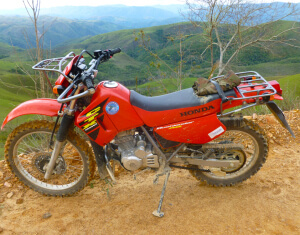
With support from ABC, Asociación Armonía bought a Honda motorcycle for Ferrufino to use in his field work. We love the ABC sticker on the back!
Photo by W. Ferrufino
Although I did not see a Palkachupa Cotinga, I'm happy to report that recently, we helped make it easier for Ferrufino to see them. With support from ABC, Asociación Armonía bought a Honda CTX 200cc motorcycle for Ferrufino's field work. He rides it all the time now, which helped him find a record number of Palkachupa nests in 2012—including ten that he had never seen before.
The author acknowledges Jeff & Connie Woodman, and Gwen Brewer, generous donors who supported this project.
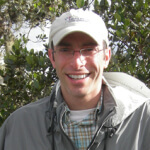 Dan Lebbin is a Conservation Biologist with American Bird Conservancy. A birder since childhood, Daniel also enjoys bird illustration and photography, and his images appear in a variety of publications.
Dan Lebbin is a Conservation Biologist with American Bird Conservancy. A birder since childhood, Daniel also enjoys bird illustration and photography, and his images appear in a variety of publications.


















































